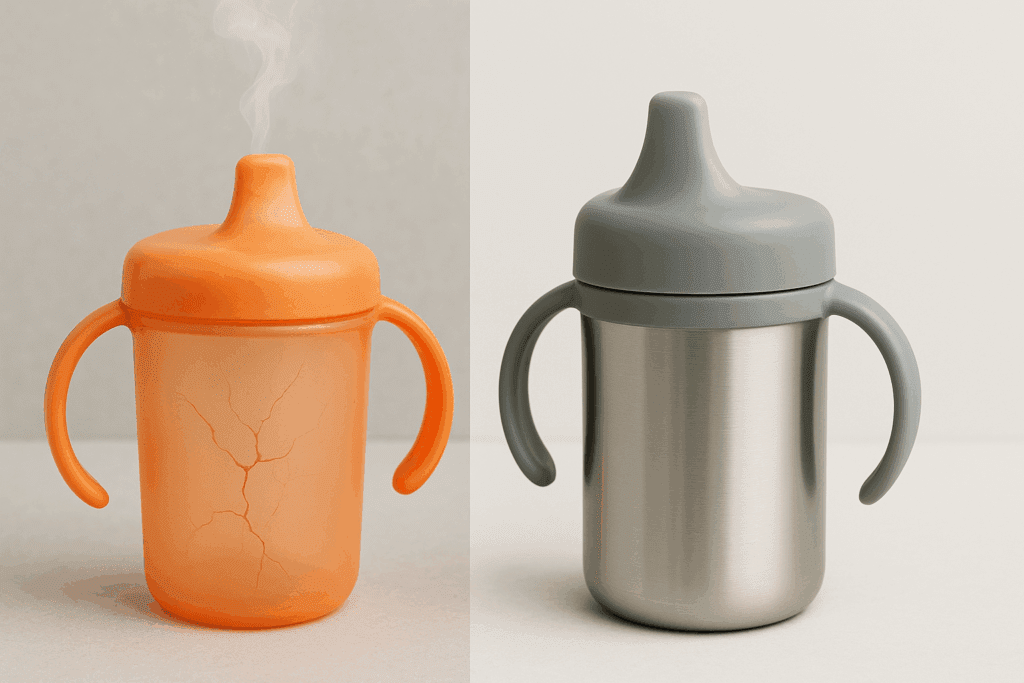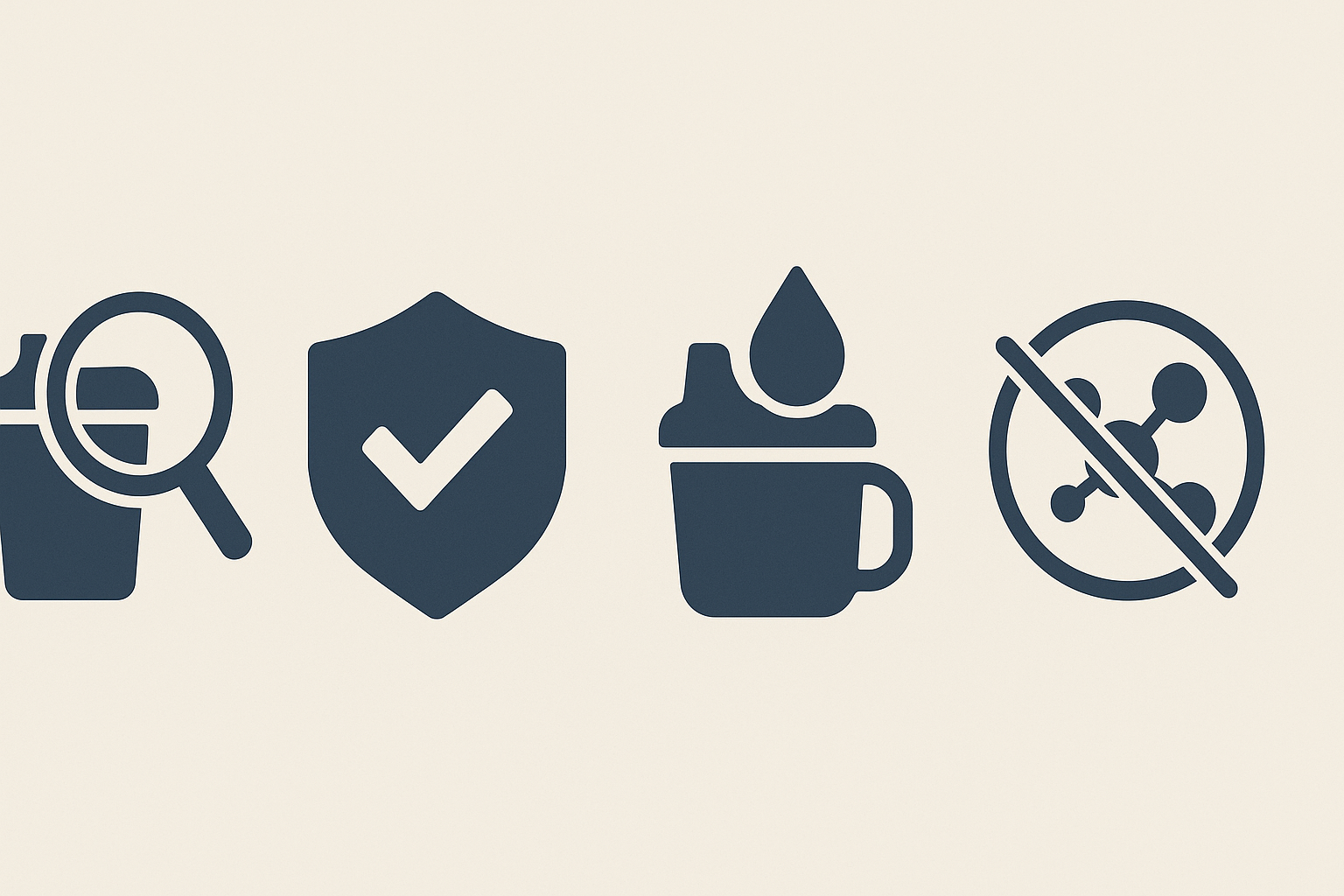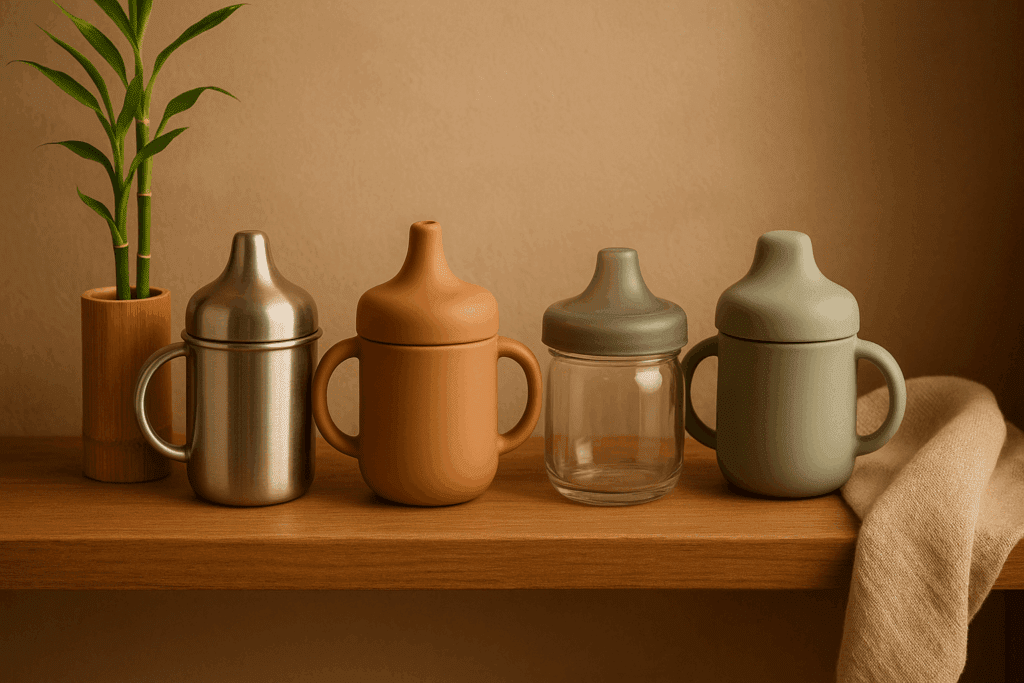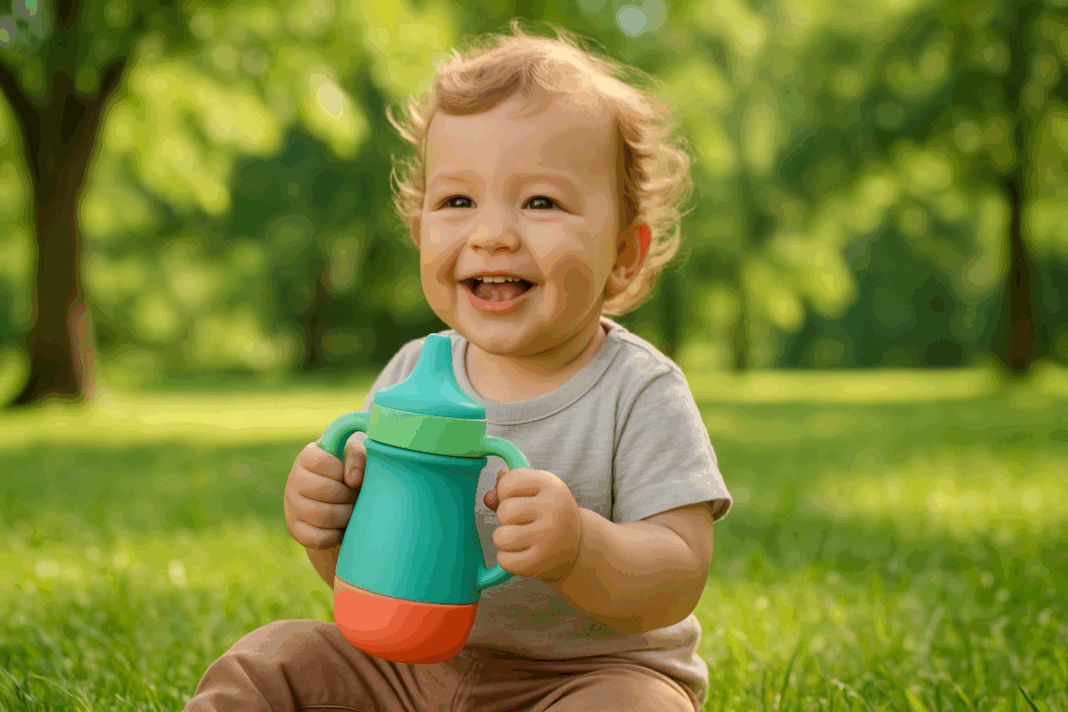The conversation surrounding safe hydration for children is evolving, with increasing attention placed on the materials used in everyday drinking tools. Among parents and caregivers, one product has drawn growing concern and interest alike—the plastic sippy cup. While once regarded as the gold standard for transitioning from bottles to open cups, plastic sippy cups now face scrutiny due to potential health and environmental risks. In light of emerging data and greater awareness, many health-conscious families are turning toward safer alternatives like the plastic free sippy cup. This comprehensive guide offers a deep dive into why choosing a plastic-free sippy cup matters, how it aligns with better hydration habits for kids, and what to consider when making this critical selection for your child’s developmental and nutritional milestones.
You may also like: The Ultimate Guide to Choosing the Best Sippy Cup for Healthy Hydration and Growing Kids

Understanding the Hidden Risks of Plastic in Children’s Drinkware
Plastic, while long valued for its convenience and affordability, has become the subject of widespread concern due to the presence of chemical compounds like BPA (bisphenol-A) and phthalates. These substances, commonly found in many plastic products, are known endocrine disruptors. This means they can mimic hormones and potentially interfere with a child’s developing endocrine system, leading to long-term developmental, neurological, and reproductive effects. Even BPA-free plastics may not be entirely safe, as many manufacturers have replaced BPA with structurally similar compounds such as BPS (bisphenol-S), which may pose similar health threats.
For young children whose bodies are still maturing, the exposure to these chemicals—even in small doses—can have cumulative impacts. Studies have indicated that prolonged use of plastic drinkware, especially when exposed to heat or wear and tear, can leach microplastics and synthetic chemicals into drinks. Given that children drink fluids multiple times per day, the risk of repeated exposure becomes a real concern. These findings underscore why more families are gravitating toward options that eliminate plastic from the equation entirely, such as non plastic sippy cup designs made from stainless steel, silicone, or tempered glass.
In addition to health concerns, plastic’s environmental impact is no longer a distant issue. As millions of plastic products end up in landfills and oceans every year, making the shift toward sustainable alternatives has become both an ecological and ethical imperative. Choosing a plastic free sippy cup isn’t just a decision about what’s best for your child today—it’s also a step toward a healthier planet tomorrow.
Why a Plastic Free Sippy Cup Promotes Healthier Hydration Habits
Hydration is an essential pillar of a child’s growth, directly affecting everything from brain development and energy levels to digestion and immune function. Yet, the quality of what they drink from is just as important as how much they drink. The shift to a plastic free sippy cup does more than minimize toxic exposure—it can enhance the entire hydration experience.
Children are sensory learners, and the materials in their drinking vessels can influence their willingness to hydrate. A well-designed non plastic sippy cup made from safe, tactile-friendly materials like silicone or stainless steel can make drinking more appealing. The feel, weight, and even the temperature retention of these materials can create a more enjoyable and interactive experience for toddlers. For example, stainless steel sippy cups often keep beverages cooler for longer periods, which can be especially beneficial during warm months when hydration needs increase.
Moreover, promoting the use of high-quality, reusable drinkware fosters positive associations with hydration. When children are encouraged to take responsibility for their own drinking habits—whether it’s bringing their favorite sippy cup to daycare or choosing what to fill it with—they’re more likely to develop long-lasting healthy routines. In this sense, the choice of a plastic free sippy cup can be seen as a foundational investment in lifelong wellness habits.

Plastic Free Sippy Cup Materials: Evaluating the Safest Alternatives
When it comes to selecting a plastic free sippy cup, the material used plays a pivotal role in ensuring safety, durability, and comfort. There are several non-plastic options available, each with its unique advantages. Stainless steel, for example, is a top choice for durability and hygiene. It is non-reactive, meaning it doesn’t leach chemicals into liquids, and it is resistant to bacterial buildup. These cups often come with insulated walls that keep drinks at stable temperatures, which is particularly advantageous for milk or formula.
Another increasingly popular option is food-grade silicone. Soft, lightweight, and flexible, silicone sippy cups are perfect for younger children who are still developing motor skills. Their pliable texture reduces the risk of injury if dropped or used aggressively, and they are easy to clean. Additionally, many parents appreciate that silicone does not retain odors or flavors, making it an excellent material for transitioning between various beverages throughout the day.
Tempered glass is a third alternative gaining traction in the world of non plastic sippy cups. Unlike traditional glass, tempered glass is designed to be more resistant to shattering. These cups are often encased in a silicone sleeve for added protection and grip, making them surprisingly kid-friendly. Glass is completely inert, meaning it will never leach chemicals or microplastics, regardless of temperature or usage. While less common than silicone or stainless steel, glass cups offer unparalleled purity and peace of mind.
Each of these materials presents a compelling case for parents seeking safer hydration tools. The decision often comes down to personal priorities—whether it’s durability, sensory experience, ease of cleaning, or eco-conscious production methods.

Choosing a Plastic Free Sippy Cup for Every Developmental Stage
Children progress through various stages of motor and cognitive development, and their hydration tools should support these transitions. The best plastic free sippy cup will evolve with a child’s growing skills while remaining safe and supportive throughout.
For infants just beginning to move away from bottle feeding, silicone sippy cups with soft spouts or straw tops are ideal. These offer a gentle introduction to independent drinking while protecting developing gums and teeth. As toddlers gain more control and coordination, a stainless steel or glass cup with handles can encourage more confident drinking. Some models come with interchangeable lids—spout, straw, or open—which can be swapped out as the child grows. This flexibility is both economical and environmentally responsible, allowing parents to support multiple milestones with a single, high-quality cup.
Preschool-aged children may be ready to graduate to open cups or training cups with minimal spill features. At this stage, encouraging open-cup drinking can help refine oral motor development, promote healthier swallowing patterns, and reduce dependence on sucking mechanisms. A plastic free sippy cup with a removable lid or transition ring can facilitate this step without risking messes or discouraging the child.
What matters most across all developmental stages is ensuring that the hydration tool aligns with the child’s physical abilities and comfort. Overly rigid or complicated mechanisms can frustrate children and lead to reduced fluid intake. The best non plastic sippy cup designs consider these practical aspects while keeping health and safety at the forefront.

Plastic Free Sippy Cup Safety Standards and Certifications to Know
When choosing any product for children—especially one that holds food or liquid—understanding safety certifications is critical. A reputable plastic free sippy cup will typically undergo rigorous third-party testing to ensure compliance with health and safety standards.
For U.S.-based consumers, the FDA (Food and Drug Administration) regulates materials intended for food contact, including drinkware. Look for cups labeled as FDA-compliant, which signifies that the materials meet stringent requirements for purity and chemical stability. Cups that meet CPSIA (Consumer Product Safety Improvement Act) standards are also important, as this legislation mandates limits on lead, phthalates, and other harmful substances in children’s products.
Additional certifications to look for include LFGB (a German standard recognized globally for food safety), which is especially relevant for silicone products. NSF International certification can offer added assurance for stainless steel items, particularly regarding heavy metal content. It’s worth checking if the manufacturer voluntarily submits their cups to third-party testing and openly shares their findings—transparency is often a reliable indicator of product integrity.
Beyond labels and certifications, it’s important to consider practical safety features. Does the cup have a secure, leak-proof seal? Are all parts easy to disassemble and clean thoroughly? Is there any part of the cup that could become a choking hazard if detached? Responsible design should reflect not only material safety but also everyday usability that keeps children protected during all stages of hydration.

Environmental Benefits of Switching to a Plastic Free Sippy Cup
Choosing a plastic free sippy cup doesn’t just benefit individual children—it’s a decision that reverberates across ecosystems and generations. Plastic pollution remains one of the most urgent environmental crises of our time, with single-use and disposable plastic items contributing significantly to the problem. Although sippy cups may seem small, their cumulative impact adds up when multiplied across millions of families.
Non plastic sippy cups—especially those made from stainless steel, silicone, or glass—are built for longevity. A single high-quality cup can last through multiple children or serve varied purposes as a child grows. In contrast, plastic alternatives often degrade quickly, cracking or warping with repeated use, leading to frequent replacements and greater landfill waste. Moreover, many plastic-free options are fully recyclable or composed of renewable materials, reducing their environmental burden even at the end of their life cycle.
Another key consideration is the carbon footprint of production. Stainless steel manufacturing, while energy-intensive, often involves higher recycled content and lower emissions over time due to its durability. Silicone production, too, has seen innovations aimed at reducing waste and energy consumption, especially when compared to petroleum-based plastics. By investing in reusable, durable sippy cups made from sustainable materials, families actively participate in reducing pollution, conserving resources, and modeling responsible consumption for the next generation.
This eco-conscious decision also lays the foundation for teaching children about environmental stewardship. When toddlers see their caregivers choosing reusable over disposable items, they internalize the value of sustainability in everyday choices. Conversations about why we avoid plastic, how we care for our belongings, and where our products come from can shape a child’s ethical compass from a young age.
How to Transition from Plastic to a Non Plastic Sippy Cup Smoothly
Transitioning from a traditional plastic sippy cup to a plastic free alternative can feel daunting, especially if your child has formed habits around a specific cup. However, with thoughtful preparation and a bit of patience, the shift can be seamless and even enjoyable. Start by introducing the new cup during calm, positive moments—such as snack time or story time—when your child is relaxed and receptive. Talk about the new cup in enthusiastic terms, describing it as their “special new cup” that’s just right for big kids.
Let your child explore the new sippy cup with their senses. Allow them to hold it, feel the texture, and examine the lid or spout. This tactile exploration helps build familiarity and trust, especially with materials like silicone or stainless steel, which may feel different from plastic. Offering the same favorite drink they’re used to—such as milk, water, or diluted juice—can further ease the transition. By pairing the familiar with the unfamiliar, children often adjust more readily to new experiences.
It’s also helpful to lead by example. When children see parents or older siblings using non plastic drinkware, they are more likely to mimic the behavior. If possible, create a visual association by matching their sippy cup material with your own drinking vessel. For instance, if they’re using a stainless steel sippy cup, drink from a stainless steel tumbler yourself. Reinforcing the idea that this is a family-wide commitment fosters a sense of inclusion and pride.
Remember that change takes time. Some children may switch instantly, while others may need several weeks to make the full transition. Be patient, offer praise for small steps, and avoid turning the process into a power struggle. With consistent encouragement and positive reinforcement, even the most reluctant little ones can come to love their new plastic free sippy cup.
Plastic Free Sippy Cup Design Features That Support Healthy Hydration
Beyond the materials themselves, thoughtful design plays a critical role in ensuring that a plastic free sippy cup promotes healthy hydration habits. For instance, an ergonomic design that allows children to grip and tilt the cup easily can make all the difference in encouraging frequent use. Features such as easy-to-hold handles, slip-resistant silicone sleeves, and contoured shapes tailored to tiny hands can boost confidence and independence in drinking.
Flow control is another important factor. Some children may prefer a free-flowing spout or straw, while others benefit from cups that regulate the amount of liquid released. The latter can prevent choking, reduce messes, and help children pace their intake—particularly useful during hot weather or periods of increased physical activity. Cups with interchangeable flow settings offer the most flexibility as children grow and develop new drinking skills.
Leak-proof lids are highly sought after, especially for use in car seats, strollers, and lunchboxes. However, not all leak-proof mechanisms are created equal. Some require excessive suction or effort, which can discourage drinking or strain young facial muscles. The ideal design balances spill prevention with ease of use, allowing children to sip comfortably without frustration.
Lastly, cleaning convenience should never be overlooked. A good plastic free sippy cup should come apart easily and allow access to all internal surfaces. Narrow necks, hidden valves, or hard-to-reach crevices can harbor bacteria or mold, especially when milk or juice is involved. Dishwasher-safe parts made from durable materials like silicone or stainless steel are especially valuable for busy parents aiming to maintain hygiene with minimal effort. A well-designed cup that promotes both usability and sanitation supports the broader goal of healthier hydration for growing children.
Long-Term Health and Developmental Benefits of Ditching Plastic
The benefits of switching to a plastic free sippy cup extend far beyond the immediate reduction of toxic exposure. Over time, this choice supports a cascade of positive outcomes for children’s health, growth, and development. First and foremost, eliminating plastic from drinking vessels helps reduce the child’s total body burden of synthetic chemicals, particularly hormone-disrupting compounds. This is especially important during infancy and early childhood, when hormonal systems are laying the groundwork for puberty, metabolism, cognitive development, and immune function.
Additionally, using high-quality materials that do not retain odors or flavors ensures that water and other healthy beverages taste fresher, making it more likely that children will meet their daily hydration needs. Since many children are sensitive to changes in taste or smell, a cup that preserves the purity of its contents can help prevent picky behaviors or aversions to drinking altogether. Proper hydration, in turn, plays a vital role in maintaining stable energy levels, regular digestion, and optimal learning capacity.
From a developmental standpoint, many plastic free sippy cups are designed to facilitate healthier oral motor patterns. Unlike some rigid plastic cups that require strong suction or lead to overuse of the sucking reflex, silicone or open-style sippy cups encourage mature swallowing techniques and tongue placement. This can be particularly beneficial for speech development and dental alignment, reducing the likelihood of future orthodontic concerns or articulation issues.
Perhaps most importantly, the decision to avoid plastic helps shape a child’s values and awareness of their body and environment. By choosing a safe, sustainable, and health-forward product like a non plastic sippy cup, parents are teaching their children—through example—that their health is worth protecting and that everyday choices matter.

Plastic Free Sippy Cup Brands That Prioritize Safety and Sustainability
Navigating the crowded market of children’s products can be overwhelming, but a growing number of brands have risen to the challenge of creating truly safe, eco-friendly, and well-designed plastic free sippy cups. These companies often go beyond minimum safety standards to offer transparency, third-party testing, and ethical manufacturing practices.
Brands like Pura Kiki, for instance, offer modular stainless steel cups that grow with your child, allowing spout, straw, and open cup attachments to be interchanged on the same bottle. This reduces waste and supports multiple developmental stages, making them a favorite among minimalist and eco-conscious families. Similarly, Green Sprouts produces glass sippy cups encased in protective silicone sleeves, combining the inert nature of glass with kid-friendly functionality.
Silicone-focused brands such as EZPZ and Mushie offer ergonomic, easy-to-clean designs that are ideal for younger toddlers. These cups are typically lightweight, soft to the touch, and available in aesthetically pleasing colors that appeal to both children and parents. Many of these companies also commit to sustainable packaging, carbon-neutral shipping, or giving back to environmental causes.
When evaluating brands, it’s important to consider more than just price or aesthetics. Read reviews from other parents, check for safety certifications, and explore the company’s mission statement. Many brands now openly share their sourcing practices, manufacturing processes, and product testing results—offering peace of mind to discerning families who demand nothing less than excellence.

Common Mistakes to Avoid When Choosing a Non Plastic Sippy Cup
While the move away from plastic is a step in the right direction, not all non plastic sippy cups are created equal. One of the most common mistakes parents make is assuming that “BPA-free” automatically means safe. As discussed earlier, BPA replacements such as BPS or BPF can pose similar health concerns. Therefore, choosing a plastic free sippy cup—made without any synthetic plastics at all—is the most reliable approach to ensuring safety.
Another frequent misstep is selecting a cup based solely on appearance or marketing claims. Some products are labeled as “eco-friendly” or “non-toxic” without offering verifiable proof or certifications. Always dig deeper into a brand’s material sourcing, transparency, and testing methods before making a purchase. Reputable companies will make this information readily available, while vague or evasive language should be a red flag.
Additionally, parents sometimes choose a cup that doesn’t align with their child’s developmental stage or abilities. A heavy glass cup might be perfect for a preschooler but overwhelming for a 10-month-old. Conversely, a soft silicone cup may be too gentle for a rambunctious three-year-old who’s ready for more advanced hydration tools. The key is finding a design that matches your child’s current skills while encouraging growth and independence.
Cleaning complexity is another overlooked issue. Cups that are hard to disassemble or contain hidden parts may compromise hygiene over time. Look for models with simple components that are dishwasher-safe and easy to inspect. Poor maintenance can lead to mold, bacteria buildup, or foul odors—all of which defeat the purpose of choosing a healthier sippy cup.
Empowering Healthier Choices with a Plastic Free Sippy Cup
In the end, selecting a plastic free sippy cup is about more than swapping materials—it’s about aligning everyday routines with a larger vision of health, safety, and sustainability. Every sip a child takes represents an opportunity to reinforce that vision, from the purity of the materials to the empowerment of independent hydration. The ideal cup supports your child’s development, simplifies your parenting experience, and minimizes your ecological footprint—all in one thoughtfully crafted product.
By prioritizing a high-quality non plastic sippy cup, families not only protect their children from harmful chemicals but also contribute to a movement that values transparency, responsibility, and care. The ripple effects of this decision reach beyond the kitchen table, shaping behaviors, habits, and values that will endure for a lifetime. Whether you’re navigating early infancy or preparing a preschooler for their first day of school, the journey toward safer, healthier hydration begins with the simple but powerful choice to ditch plastic for good.
Frequently Asked Questions: Choosing the Right Plastic Free Sippy Cup for Your Child
What Are the Long-Term Cognitive Benefits of Using a Plastic Free Sippy Cup?
While the immediate benefits of a plastic free sippy cup relate to chemical safety and hydration, its use may also support better cognitive outcomes in the long run. Children exposed to fewer endocrine-disrupting chemicals—commonly found in plastic—may experience fewer disruptions in neurodevelopmental processes. Brain development during early childhood is critically sensitive to environmental factors, and prolonged exposure to BPA-like compounds has been linked to attention disorders and impaired executive function. By minimizing these exposures, parents can help support more stable emotional regulation, impulse control, and memory formation. Furthermore, consistent hydration using safe materials helps sustain energy levels and cognitive clarity, especially during formative learning stages at daycare or preschool.
How Can I Encourage a Reluctant Toddler to Use a Non Plastic Sippy Cup?
Transitioning from a familiar cup to a non plastic sippy cup can be met with resistance, but a few creative strategies can smooth the process. Start by allowing your toddler to personalize their new cup with stickers or a name tag to foster a sense of ownership. Involve them in the selection process by letting them choose the color or design from a few pre-approved, safe options. Introducing the cup during playtime—rather than mealtime—can reduce pressure and increase acceptance. Also, using storytelling techniques like pretending the cup is a character on an adventure may shift attention from unfamiliar materials to fun interaction. Positive reinforcement, rather than force or urgency, will be key to a successful switch.
Is a Plastic Free Sippy Cup More Hygienic Than Traditional Plastic Versions?
Yes, a plastic free sippy cup can offer significant hygiene advantages, particularly when it’s made from non-porous materials like stainless steel or tempered glass. Unlike plastic, which may absorb odors and stains over time, these alternatives resist microbial buildup and remain easier to sanitize. Silicone parts can be sterilized in boiling water without degrading, while stainless steel cups can often be cleaned in a dishwasher at high heat, ensuring thorough sanitation. Additionally, some plastic-free designs have fewer crevices and detachable valves, reducing the risk of mold growth in hidden areas. Overall, switching to a non plastic sippy cup not only minimizes chemical exposure but also helps maintain cleaner, safer hydration tools over time.
What Role Does Material Sensory Feedback Play in Cup Preference and Use?
The tactile and thermal sensations provided by a sippy cup can significantly influence a child’s comfort and willingness to hydrate. A plastic free sippy cup made of silicone feels soft and flexible, ideal for teething toddlers who enjoy sensory exploration. In contrast, stainless steel offers a cool, solid feel and can enhance a child’s awareness of temperature changes, adding to sensory engagement. These textures and temperature feedback loops may also support neurodevelopmental milestones related to oral-motor skills and tactile discrimination. By choosing a material that aligns with your child’s sensory preferences, you may increase hydration frequency and support more consistent fluid intake throughout the day.
What Innovations Are Emerging in the Design of Non Plastic Sippy Cups?
Recent innovations in non plastic sippy cup design are redefining the standards of child hydration products. Manufacturers are now exploring biodegradable and plant-based silicone alternatives to further reduce environmental impact. Some brands have integrated anti-microbial elements into cup surfaces, reducing bacterial growth between cleanings without the need for harsh chemical treatments. Modular sippy cups that convert into snack containers or open training cups offer extended usability, aligning with minimalist parenting trends. In addition, user-focused features like liquid volume indicators, sensory-textured grips, and thermochromatic finishes (which change color with temperature shifts) are helping caregivers and children interact with the cup in smarter, safer ways. These advancements reflect the industry’s commitment to function, safety, and sustainability.
Can a Plastic Free Sippy Cup Reduce the Risk of Pediatric Dental Issues?
Yes, choosing the right non plastic sippy cup can support better oral health and help reduce the risk of dental problems such as misalignment, bottle rot, or improper tongue posture. Many plastic cups rely on hard spouts that can encourage prolonged sucking habits, interfering with the development of natural swallowing and speech patterns. A plastic free sippy cup with a soft silicone spout or a straw encourages a more mature drinking technique that minimizes pooling of sugary liquids around the teeth. Open-style cups or those with flow-control lids also help prevent overconsumption of juice or milk, a key factor in preventing early childhood cavities. Collaborating with pediatric dentists, some brands now incorporate orthodontic-friendly designs into their cups, further reinforcing dental wellness.
How Do Social and Environmental Values Influence the Shift Toward Non Plastic Sippy Cups?
Parents are increasingly driven by a desire to align their purchasing decisions with broader social and environmental ethics. Choosing a plastic free sippy cup reflects not only a health-conscious mindset but also a commitment to reducing reliance on petrochemical products. Many families view this choice as a small but powerful act of environmental stewardship, contributing to waste reduction and sustainable consumption models. Beyond environmental motivations, parents often report that this switch reinforces lessons about responsibility and mindful living to their children. As society places greater emphasis on ethical consumerism, selecting a non plastic sippy cup becomes an expression of both personal values and public awareness.
What Are the Travel Considerations for a Plastic Free Sippy Cup?
When traveling with young children, practical concerns about weight, leak resistance, and temperature retention are paramount. A stainless steel plastic free sippy cup is particularly suited for travel because of its durability and insulation properties, keeping drinks cool during long outings. Some models come with screw-on lids or lockable spouts to prevent spills inside bags, while lightweight silicone-based cups may offer foldability for compact storage. Parents should also look for compatibility with car cup holders and stroller trays, ensuring the cup remains easily accessible. It’s worth packing a cleaning brush or sanitizing wipes to maintain hygiene on the go, especially for models with narrow straws or valves.
Why Do Some Children Prefer One Plastic Free Material Over Another?
Children’s preferences for sippy cup materials often stem from a combination of developmental readiness, sensory feedback, and previous experiences. For instance, a toddler accustomed to a lightweight plastic cup may initially resist the weight of stainless steel. However, with gradual exposure, they may come to appreciate its temperature retention and tactile appeal. Others may gravitate toward the softness of silicone, particularly during teething phases when biting or chewing provides relief. Additionally, children with sensory processing sensitivities may respond differently to certain textures or temperatures, making it essential for parents to observe and adapt accordingly. Offering a variety of non plastic sippy cup options may be the best way to identify which material aligns with your child’s preferences and needs.
Are There Educational Opportunities Hidden in the Use of a Plastic Free Sippy Cup?
Yes, using a plastic free sippy cup can be a gateway to early environmental and health education. Parents can use daily interactions with the cup to start age-appropriate conversations about recycling, healthy habits, and caring for the planet. Explaining why you chose a cup without plastic helps children internalize the importance of conscious decision-making. Some families extend this learning by reading children’s books on sustainability, watching nature documentaries together, or visiting local farmers’ markets to reinforce eco-friendly values. These early lessons, reinforced through tangible tools like a non plastic sippy cup, lay the groundwork for lifelong habits of mindful living, civic engagement, and personal health responsibility.
Conclusion: Supporting Healthy Hydration and Child Wellness with a Plastic Free Sippy Cup
As the dialogue around child health and environmental responsibility continues to deepen, the humble sippy cup has become a powerful symbol of change. Choosing a plastic free sippy cup may seem like a small decision, but it holds far-reaching implications for your child’s immediate well-being and long-term development. From minimizing exposure to endocrine disruptors to supporting oral motor development and encouraging sustainable habits, the benefits of ditching plastic are multifaceted and compelling.
The materials you select—whether stainless steel, silicone, or tempered glass—speak volumes about your commitment to safer choices. Likewise, thoughtful attention to design, functionality, and cleaning ease ensures that hydration remains not only safe but also enjoyable. When your child reaches for their cup and drinks with ease and confidence, you’ll know that your decision has laid a solid foundation for lifelong wellness.
More than a trend, the rise of the non plastic sippy cup represents a cultural shift—one that honors science, prioritizes safety, and respects the planet we share. By making informed, mindful choices, you become part of that shift. And in doing so, you equip the next generation with tools that nurture both their health and their humanity, one sip at a time.
Further Reading:
The Ultimate Guide to Choosing the Best Sippy Cup for Your 6-Month-Old
The Ultimate Guide on Choosing the Perfect Spout Sipper Cup for Your Baby



